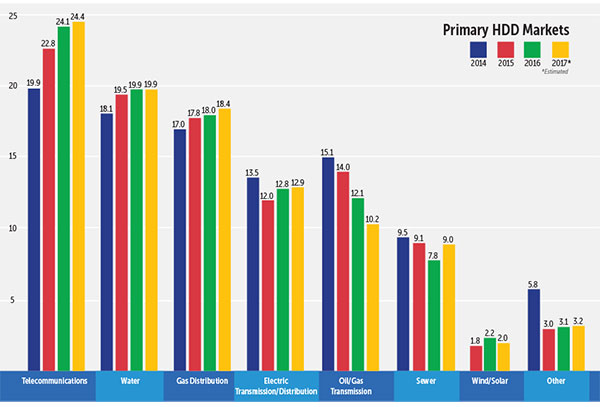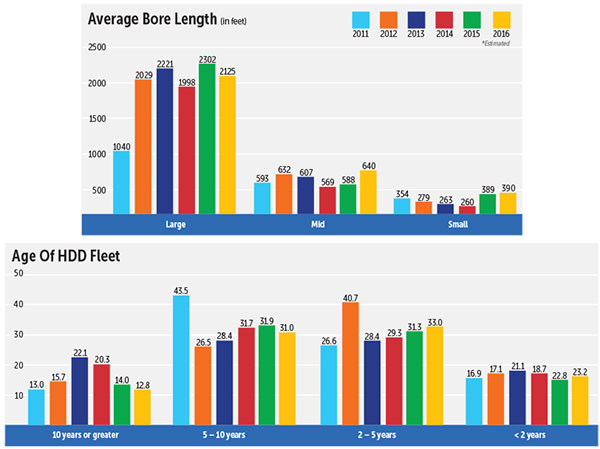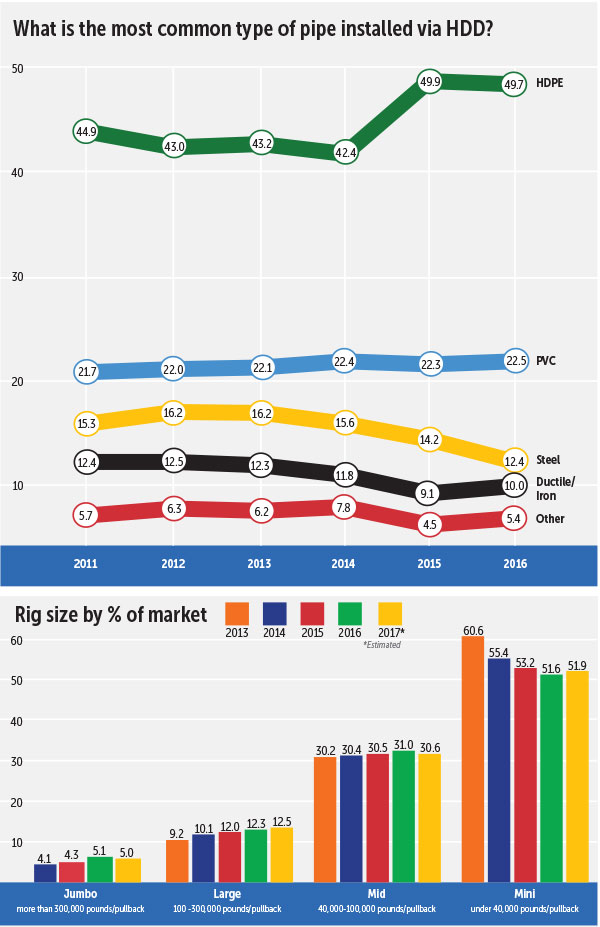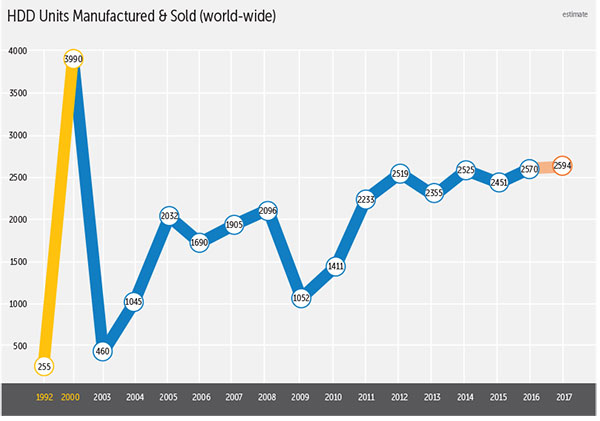June 2017 Vol. 72 No. 6
Features
HDD Sustains Robust Growth; Common Issues Remain

19th Annual Horizontal Directional Drilling Survey
Who would have thought, just a few years ago, that horizontal directional drilling (HDD) would be taken for granted? Yet for much of the underground utility infrastructure pipe/conduit installations, it is rare that HDD is not at least seriously considered as a viable, cost-effective and productive solution.
The maturity of HDD has reached the point that both veteran and young engineers alike are familiar with the capabilities of HDD and, when designing projects, weigh directional drilling equally with conventional open-cut options.
HDD has become a staple of underground infrastructure work and that has been reflected in the continued strength of the technology. It has spread to virtually all types of pipe installation with unique and creative uses of HDD being constantly developed. In some ways, HDD is becoming the Swiss Army Knife of trenchless pipe and conduit installation.
The 19th Annual Underground Construction HDD Survey reveals the strength, versatility and growth of the market in the United States. This exclusive industry research was conducted during March and April. It surveyed contractors and organizations that actively own and operate HDD units to enable a statistical portrayal of the market.
While 2016 provided a mixed bag of market opportunities for HDD contractors, 2017 has become a steady business year in most sectors, with encouraging and increasing activity for large rigs.
Stable and healthy
Changes in market share for various industry segments were relatively stable and the significant shifts that are projected through 2017 are largely predictable. Telecommunications installation, driven by the fiber-to-the-premises wave, increased its market share from 24.1 percent in 2016 to 24.4 in 2017. The need for speed (and volume) made possible by fiber optics has driven applications at a steady rate, fueling consistent telecom work potentially for several years to come.
Water installation was unchanged at a 19.9 percent market share. Gas distribution work is increasing as it is experiencing growth from an 18 percent market share in 2016 to 18.4 percent in 2017. Electric transmission and distribution claimed a 12.9 market share, wind/solar projects were down slightly to a 2 percent market share and other applications climbed slightly to 3.2 percent.
More significant changes came in the sewer market which saw its share climb after a drop in 2016. In 2017, sewer work should account for 9 percent of the market.
Contractors, for the most part, seemed bullish on HDD prospects for the foreseeable future. “I think we’re going to be very busy for eight-plus years,” said this upper Midwest respondent. Observed a Southwest contractor, “It’s going to continue to grow in our region.”
“We see nothing but positive growth,” stressed a Northeast contractor. A respondent from the Southwest pointed out that “HDD work has become excellent for water and sewer markets which is what we specialize in.” This should be considered a strong statement since less than 10 years ago, HDD for sewer and water was just getting started.
Despite the positive outlook for overall HDD work, the industry is experiencing its fair share of challenges. Workforce issues abound, mud disposal is still a sensitive – and expensive – issue in much of the country, and both federal and local restrictions/regulations remain overwhelming at times, according to survey respondents.
Among the most common complaints is project pricing. “Too many contractors are consistently underpricing the work,” stated this West Coast contractor. “If we are legitimately out-bid, we can live with that. But too many of these guys leave too much on the table and then struggle to complete a job and make any money. They usually just mess up a job and that hurts everybody.”
Another common issue cited was distrust of contract locating companies. The majority of HDD companies now locate utilities and obstructions themselves – even after contract locating companies from One-Call have exposed utilities. “We learned long ago – and the hard way – that too many contract locators are not well-trained. We cannot afford to take such risks,” pointed out this Southeast contractor.
The move to more sophisticated HDD rigs and supporting equipment continues. Constant refinement and inclusion of electronic and digital advances have driven the industry forward, steadily increasing productivity and efficiency. “It’s amazing the differences in the rigs over the last few years,” said a Midwest contractor. “The sophistication has really allowed us to take on projects that we wouldn’t have in the past.”

Market summaries
Not surprisingly, as oil and gas projects wrapped up in 2016, the amount of work for 2017 dropped off to 10.2 percent of the market. However, on a positive note, a flurry of pipeline projects in the spring could bolster HDD work in the transmission markets for 2018 and beyond. The solid backing for energy projects by the Trump administration plus efforts to legislate pipeline projects more expeditiously by Congress are encouraging additional activity in the energy sector. Of course, stable and/or higher prices are the ultimate driving force and until international economies rebound further, energy pipeline work remains extremely fluid.
A contractor that does substantial drilling work for energy companies had an interesting observation. “HDD is growing and is very necessary with all the conflicts coming against energy companies.”
Telecommunications construction, primarily fiber optic, continues to drive the small to medium HDD rig market. Some were concerned when Google Fiber elected to scale back its expansions plans. However, many analysts believe that Google never intended to be a fiber system owner/operator. Rather, Google wanted to stimulate major high-speed internet build-outs around the country to facilitate technological needs which typically require fast internet access. Whatever the reasoning, Google’s withdrawal has not seemed to slow the telecom construction mania as large companies such as AT&T, along with scores of other firms, are spending billions to expand the U.S. fiber network with no slow-down in site.
Electric grid work also remains strong for the time being. Experts keep expecting the work to slow, but that hasn’t happened yet. In fact, some reports are expecting active electric grid construction for at least five more years. Also, for electric transmission lines, more work is slowly but surely being engineered for underground installations, which is one of the last remaining frontiers to be conquered by HDD.
Gas distribution work is solid, but new construction still lags rehabilitation and replacement work. However, in parts of the country, new gas line activity is heating up and HDD is playing a key role in that. All outlooks call for distribution installation work to continue to gain strength in the coming years, which bodes well for small to medium HDD work.
Water remains a strong HDD market, with the potential to grow even further in the aftermath of the Flint, MI, lead pipe scare. The Flint situation was clearly an aberration that could have been avoided. However, the Flint event did serve to draw additional attention to the dismal condition of much of our water infrastructure. Predictably, cities are having a knee-jerk reaction to citizen concerns about neglected water infrastructure.
It may be 2018 before substantial monies for water systems actually materialize in municipal budgets, but when that happens, not only water rehabilitation work will receive a boost, but new installation and replacement of water pipe should grow substantially, as well. HDD is becoming a preferred method for much of the water pipeline work, particularly pressurized water transmission installation which often has to go deeper underground and longer distances.
While small to medium HDD rigs can often do this work, the transmission pipeline installations are larger diameters of PVC, HDPE or steel pipe which require larger rigs. Many HDD contractors have historically shied away from public works contracting, but the growing demand for HDD in water applications has stirred renewed interest – especially for those contractors with large rigs that have seen a dramatic slow-down in their energy related work over the past three years.
Indeed, large rig work has spread far outside the boundaries of energy pipelines. Water, electric transmission, fiber optic conduit – even sewer force mains – have all become increasingly popular markets for HDD installation, frequently requiring larger equipment to cover project scopes and logistics.
For several years, large HDD contractors were in high demand as the energy pipeline construction boom necessitated tremendous amounts of directional drilling. Those “wild west” days with project backlogs of a year or longer experienced a dramatic slowdown in 2015, along with the pipeline projects. Still, work continued into 2016 to complete pipeline projects already underway. But by the middle of 2016, those projects were completed and new pipeline work was slow to emerge. With the business-friendly approach of the President Trump administration, there has been a renewed flurry of recent pipeline activity and project announcements. Regardless, 2017 is shaping up to be a much stronger year for HDD work in energy than 2016.
HDD work for sewer force mains continues to gain market share, as well. While directional drilling is utilized for some gravity work, that still remains elusive.
Have job, will hire
Workforce issues continue to plague drillers of all sizes. At the Underground Construction HDD Round Table held in conjunction with UCT 2017 in Fort Worth, TX, it was apparent just how strongly the issue of hiring and retaining quality personnel was impacting the HDD market – just like much of the overall construction workforce. Panel members and audience alike cited examples of extreme steps they were taking to locate, train and retain quality labor. “We are competing with a lot of other companies for available labor in areas we work. It has hindered our growth,” commented one audience member.
In the survey, several respondents from across the country lamented a dearth of quality operators. “We’re having trouble finding anyone who wants to work in the construction industry, even with something as cutting edge as HDD,” explained a West Coast contractor.
The Distribution Contractors Association, Power & Communication Contractors Association, and other groups have organized concerted workforce development initiatives ranging from training options, to connecting with younger students, to highlighting opportunities in underground infrastructure work. Manufacturers have developed various hands-on training programs, both live and through the web, as well as various simulator training. All are having a positive impact on the market.
Still, the lack of quality, trained – and available – personnel is a construction industrywide issue. Not only are HDD contractors competing with other underground infrastructure contractors to attract personnel, but the lack of skilled (or trainable) labor is a huge problem for all aspects of the construction industry.

Fleet
Mid-sized rigs, generally classified with 40,000 to 100,000 pounds of pullback force, remain an area of substantial growth. While mini rigs (under 40,000 pounds of pullback) are the bread and butter of the telecom, electric and gas distribution markets, the flexible and broader applications that a moderately sized rig offers a company are hard to resist, especially for those contractors looking to grow their companies’ capabilities.
Typically, running a medium-sized rig presents only a modest amount of additional training to develop effective mid-range operations, though often it does require a substantial equipment upgrade, such as mud recyclers/cleaners, mud motors, more advanced tracking equipment, etc.
As with any investment, most contractors track and maintain their HDD rig fleet with extreme care. Like other mainstream construction equipment (i.e. crawler-dozers, excavators and backhoe-loaders), telematics has invaded the market in force. Tracking not only rig location but productivity, maintenance needs and just about anything someone can dream up, is now possible even on the smallest of rigs. Increasingly, telematics for planning bore paths and automating the drilling process is enabling the directional drilling process to become less risky, more productive and ultimately, more profitable.
The old adage of “get the bore right the first time” has exploded upon the market in recent years, thanks to the light-year leaps in digital technology. That technology includes locating and tracking drilling operations which directly link the rig and operator. All-in-all, directional drilling is well into the digital growth phase.
That said, contractors are under constant pressure to enhance productivity, which has translated into the overall age of the HDD market, as newer equipment means more productivity tools. For 2017, contractors predict they will retire a greater percentage of their fleet in favor of more modern and technologically adept equipment.
There are still many rigs in use older than 10 years that are productive and effective on the job. But newer equipment brings advanced technology and tooling, and with the workforce challenges being faced today, modern, digital equipment is much preferred as the learning curve is shorter for new hires.
About 12.8 percent of the rigs still in active operation are older than 10 years, 31 percent are five to 10 years of age, 33 percent are two to five years old, and 23.2 percent have been purchased within the last two years.
The size of various fleets across the United States also remains relatively stable. Mini rigs claim 51.9 percent of all those in use; 30.6 percent is comprised of mid-sized rigs; large rigs stand at 12.5 percent; and maxi rigs (more than 300,000 pounds of pullback force) hold 5 percent of the market.

Bore lengths, pipe
Bore lengths for small rigs in average, non-rocky or difficult soils, were virtually the same in 2016 compared to the previous year, at 390 feet. Bore lengths for mid-sized rigs increased substantially to 640 feet, up from 588 in 2015, and large rig boring lengths averaged 2,125 feet.

High density polyethylene pipe is again the most common type utilized in the directional drilling market. HDPE is used in approximately 49.7 percent of projects, a commanding lead over other pipe types, though the use of PVC fusible and restrained joint pipe is making headway into the HDD market at 22.5 percent. Ductile iron pipe is used about 10 percent of the time and steel 12.4 percent. Other pipe types share 5.4 percent of the market.
In 2017, 50.3 percent of contractors plan on purchasing small rigs, 34.7 intend to add at least one mid-sized rig, and 15 percent are looking at buying a large directional unit. Overall, the average contracting company expects to add or replace almost two units per firm this year.

The annual HDD Survey also asks contractors what are the most important qualities they seek from manufacturers and suppliers. Service remains the most highly desirable characteristic, cited by more than 75 percent of all respondents. Technical knowledge of equipment is also very important to contractors, as it was mentioned by 69 percent, and quality was cited by 67 percent of respondents.
The current, strong market for small and mid-sized rigs sometimes leads to limited availability of equipment. With that in mind, 60 percent of contractors say availability is an issue for them. Location and supporting personnel were cited as being extremely important by 41 percent of respondents.
In total, contractors are bullish on the HDD market for the next several years.




Comments